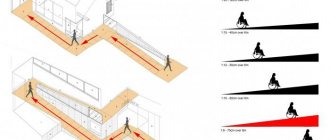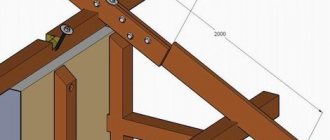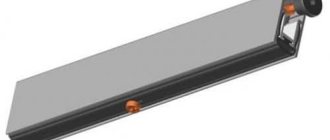The area on the horizontal section of the ramp during a straight path or at a turn must be at least 1.5 m deep (clause 3.29).
The width of the flight of stairs accessible by MGN should, as a rule, be at least 1.35 m. If the design width of the flight of stairs is 2.5 m or more, additional dividing handrails should be provided.
All steps within the flight must be of the same geometry and size in terms of tread width and step rise height. It is allowed to change the pattern of treads on the lower steps of the first flight of open stairs (clause 3.27).
The width of the treads of stairs, except for indoor ones, must be at least 0.3 m, and the height of the steps must not be more than 0.15 m. The slopes of stairs must be no more than 1:2. The steps of stairs on the routes of movement of disabled people and other groups of people with limited mobility must be solid, smooth, without protrusions and with a rough surface. The edge of the step must have a rounding with a radius of no more than 0.05 m. The side edges of the steps that are not adjacent to the walls must have sides with a height of at least 0.02 m (clause 3.28).
The maximum height of one rise (flight) of the ramp should not exceed 0.45 m with a slope of no more than 1:20 (5%).
One of the most common mistakes when creating an accessible environment is the incorrect slope of the ramp. Unfortunately, the performers, that is, the contracting construction organizations that develop the project and install the ramp, are not always competent in creating an accessible environment and do not know the rules and regulations for organizing the ramp.
Using our calculator, you can check whether the ramp angle meets accessibility standards.
Instructions:
Enter the parameters of the ramp: height - maximum number, length of the continuous flight of the ramp. Parameters must be entered in centimeters. Click the "calculate" button. The calculator will display the result of the calculated slope angle of the ramp being tested as a percentage (%). This will provide recommendations on whether the angle of inclination of the ramp being tested meets accessibility standards.
The main current regulatory document for determining the slope of a ramp and its length in the Russian Federation is SP 59.13330.2016 “Accessibility of buildings and structures for low-mobility groups of the population.”
The maximum height of one rise (flight) of the ramp should not exceed 0.45 m with a slope of no more than 1:20 (5%).
If the difference in floor heights on the paths of movement is 0.2 m or less, it is allowed to increase the slope of the ramp to 1:10 = 10%
Inside buildings and on temporary structures or temporary infrastructure facilities, a maximum ramp slope of 1:12 (8%) is allowed, provided that the vertical rise between sites does not exceed 0.5 m. When designing reconstructed, subject to major repairs and adaptable existing buildings, and structures, the slope of the ramp is taken in the range from 1:20 (5%) to 1:12 (8%).
Ramps with a height difference of more than 3.0 m should be replaced with elevators, lifting platforms, etc.
In accordance with the order of the Ministry of Construction of Russia No. 750 / order dated October 21, 2015 “On approval of changes No. 1 to SP 59.13330.2016 “Accessibility of buildings and structures for low-mobility groups of the population” “When designing reconstructed, subject to major repairs and adaptable existing buildings, and structures, the slope of the ramp is taken in the range from 1:20 (5%) to 1:12 (8%).”
What do the numbers mean:
1:20 = 5% i.e. with a height difference of 1 m, the length of the ramp should be 20 m, with a height of 0.5 m - 10 m.
1:12 = 8% - i.e. with a height difference of 1 m, the length of the ramp should be 12 m, with a height of 0.5 m - the length of the ramp should be at least 6 meters, etc.
1:10 = 10% - i.e. with a height difference of 1 m, the length of the ramp should be 10 m, with a height of 0.5 m, the length of the ramp should be 5 m, etc.
A generalization of the requirements for the arrangement of ramps will facilitate the design and installation of convenient structures for moving people with disabilities.
Determining the angle of inclination
The correct slope of the ramp is one of the key points in arranging a convenient structure for the disabled. Since the definition of slope in regulatory requirements is presented in various ways, let’s consider them in more detail:
Despite the strict requirements of building regulations, non-standard slopes are sometimes allowed. It is acceptable in the following situations:
- In the case of a temporary ramp installation (during the repair or reconstruction of a building), if its height does not exceed 0.5 m and the gap between the platforms is no more than 6 m, the slope can be 8% or 1:12, which is equivalent to 4.8 o.
- If the height of the structure does not reach 0.2 m, the slope is permissible in the proportion of 1:10, which is 10% or 5.7 o.
A summary of the stated requirements is clearly presented in the following table:
Devices for the safe movement of people with disabilities are made of high-strength steel. Depending on the installation location, they are divided into:
Types of structures
A ramp is an inclined surface designed for the movement of people with disabilities. In most cases, the structure has a straight lifting trajectory; screw-type designs are much less common. There are two groups of structures for vertical movement of disabled people - removable and non-removable. The latter, in turn, are divided into stationary and folding.
A stationary ramp for disabled people is installed at the entrance to buildings and other public places (subway descents and passages). Folding models are often found in the entrances of residential buildings, where it is not possible to install a stationary gentle descent for the disabled.
Removable ramps are not fixed in one place; they are installed on a temporary basis as needed. After completion of operation, removable structures are removed to storage. The following types of removable ramps are distinguished:
- Telescopic (sliding) models. The length of the universal design is easily adjustable.
- The main purpose of the ramp is for a wheelchair user to overcome curbs and thresholds. Due to their compactness they are easy to transport.
- The roll ramp consists of removable sections that allow you to change the length of the structure. When assembled, it resembles a rolled up rug. The use of aircraft-grade aluminum in the production of the product ensures strength and lightness to the structure.
Before you begin arranging the ramp, you must carefully read the requirements specified in SNiP and GOST.
Responsibility for the absence of ramps
Persons responsible for installing a ramp, in the event of its absence, are brought to administrative responsibility in accordance with Article 9.13 of the Code of Administrative Offenses of the Russian Federation. A fine of 2,000 to 3,000 rubles is imposed on officials, and on a legal entity from 20,000 to 30,000 rubles. If there is a ramp, but it is made with deviations from regulatory documents, a fine of 50 thousand rubles is provided for the organization involved in its construction.
Pharmacy owners bear an increased degree of responsibility. A private owner or manager of a pharmaceutical enterprise who does not provide disabled people with access to a pharmacy will pay 4-5 thousand rubles, while the enterprise itself can be fined 50 thousand rubles. The fine can be replaced by suspension of pharmacies for 3 months until a ramp is made.
The construction of ramps for people with limited mobility is regulated by:
- Article 15 of Law N 181-FZ “On the social protection of disabled people in the Russian Federation”, adopted on November 24, 1995 and amended in 2022. The amendments took effect on January 1, 2022. Town Planning Code of the Russian Federation.
- Resolution “On measures to adapt residential premises and common property in an apartment building taking into account the needs of people with disabilities” adopted by the Government of the Russian Federation on July 09, 2016.
Requirements and standards for the installation of structures intended for comfortable access for wheelchair users to residential and public buildings are specified in the following documents:
- GOST R 51261-99;
- SNiP 35-01-2001 “Accessibility of buildings and structures for people with limited mobility.”
- Design and Construction Rules 35-101-2001.
- Code of rules 59.13330.2012, latest edition of SNiP 01/35/2001.
However, when building ramps, SNiP has advantages over SP. In addition to federal laws, each region adopts its own regulations that do not contradict current legislation.
Now the presence of these products in residential buildings, as well as in public institutions, can be observed quite rarely, although such a need exists.
Requirements for the entrance area
Installing one structure is not enough. It is also necessary to take into account the size of the entrance area (for example, the top of the porch). The parameters of the standard site and other important points are described in SP 30-102-99. According to this document, entrance structures must have the following dimensions:
- minimum width – 185 cm;
- minimum depth - 140 cm when opening the door into the house or 150 cm when opening outwards;
- The minimum area for turning the stroller is 220 cm.
The main requirement for the entrance area is to ensure the ability to move wheelchairs with maximum comfort. For this reason, its area should be sufficient to rotate or move the chair. To ensure comfortable movement for people with disabilities, another standard was developed - SP 59.13330.2012. This regulatory document establishes other requirements for entrance areas. In particular:
- the structure must be equipped with a canopy and drainage system;
- in winter, if possible, the surface of the platform should be heated;
- minimum dimensions of the platform (when doors are opened outwards) – 140×200 cm or 150×185 cm;
- the platform with a ramp must be at least 2.2x2.2 m.
Handrails
Handrails must also strictly comply with certain GOST requirements, as well as SNiP standards:
From the series - if only it was...
Examples of handrails on ramps designed to move disabled people can be seen in these photos.
Installation of a stainless steel ramp
Design selection
When choosing this design, the following important points must be taken into account:
Simple removable option
It is important to remember that the most important thing in choosing and using this product is strict compliance with SNiP and GOST standards in order to ensure the safety of persons using the ramp.
GOST recommends creating restrictive elements whose height is 5 cm or more.
Non-standard products
Unfortunately, it is not always possible to install a structure that meets all of the above requirements. There can be many reasons for this, for example:
- porch or building repairs;
- lack of free space;
- presence of obstacles in the way of movement, etc.
For these and other reasons, installing a conventional model may not be possible. To correct the situation, non-standard structures are sometimes installed. Of course, they may not meet many requirements, but they provide an opportunity for disabled people to enter the building.
The fact that products may not meet certain standards does not mean that you can tilt them 40° or forget about guards. When designing, the following points must be taken into account:
- minimum width – 85-90 cm;
- mandatory presence of handrails and barriers;
- permissible slope - 15%, maximum value - 18% (allowed only in extreme cases, if it is impossible to make a smaller slope);
- the maximum span length at a larger slope is 7 m.
Railings and handrails of ramps for the disabled
To ensure the safety of movement of disabled people, ramps are equipped with railings. The requirements set out in the regulatory documentation oblige the installation of railings on both sides of the march intended for the disabled. And if the design involves the movement of people with limited mobility in both directions simultaneously, then railings are also necessary along the center line of the march. However, if the angle of inclination of the ramp surface does not exceed 5%, then the presence of handrails is not necessary.
Double sided ramp
For two-way traffic, the center line of the ramp is equipped with railings
Double height handrails are recommended. The first level is 70 cm. If the movement of disabled children is expected, then it is reduced to 50 cm. The second level is 90 cm. You can choose values from the range of 85–92 cm. This is also regulated by the joint venture (SNiP).
Double ramp handrail
If we rely on GOST R 51261-99, then the installation of handrails should be carried out if one of the following conditions is present:
- The lifting height is equal to or greater than 150 mm;
Ramp height
- The horizontal projection of the inclined surface is equal to or greater than 1800 mm.
Inclined surface of the ramp
In addition, GOST defines the first level of handrail height a little differently: 700–750 mm.The final parts of the handrails extending beyond the inclined section must be no shorter than 30 cm (sizes in the range from 27 to 33 cm are allowed) and do not have sharp edges or burrs to avoid injury.
The final part of the handrail
There should be no sharp edges on the ramp handrail
Additional requirements for ramp handrails:
- parallel to each other;
- continuity of their surface along the entire length;
- rounded section 4–6 cm;
- the distance from smooth walls is 4.5 cm, from rough walls – 6 cm.
For example, we need to calculate a ramp for the entrance to a building, the height of the porch is 0.4 m. In this case, we need to use the ratio 1:12, making a simple proportion we get L = 12 * 0.4 m = 4.8 m. We calculate the length of the inclined surface of the ramp = square root of (4.8 2 + 0.4 2) = 4.8 m The ramp can be constructed without horizontal platforms, since the length of its inclined surfaces is less than 6 m.
Current building codes
Requirements for the design of ramps for the movement of wheelchairs are determined by three current documents:
SNiP sets out in detail all the design requirements for the size of ramps for disabled people under stationary installation conditions. The required angles of inclination of the marches, their width, maximum length, dimensions of the platforms and additional installation elements in the form of railings, safety edges and others are indicated.
The Code of Rules (SP) is a more current expanded edition of SNiP. The standards specified in it differ slightly in the direction of reducing the angles of inclination of the ramp path and its maximum length, increasing the width of the passage and the dimensions of the platforms, and installing additional elements to ensure greater safety and convenient use.
However, it should be taken into account that SNiP is legislatively higher in terms of technical instructions than SP. Therefore, if the technical specifications and design documentation do not stipulate the performance of work in accordance with the requirements of the Code of Rules, then the usual standards are met.
The requirements of the State Standard and SNiP for the installation of ramps are identical, but the peculiarity of GOST is a more detailed presentation of the installation of railings. It specifies exactly in which cases the installation of railings is mandatory and sets out detailed requirements for their design.
How to calculate the angle of a ramp?
The slope of the ramp is calculated using the formula: ramp slope = H / L, where: H is the height difference that must be equipped with a ramp, and L is the length of the horizontal projection of the inclined section of the ramp (click to enlarge).
For example, we need to calculate a ramp for the entrance to a building, the height of the porch is 0.4 m. In this case, we need to use the ratio 1:12, making a simple proportion we get L = 12 * 0.4 m = 4.8 m. We calculate the length of the inclined surface of the ramp = square root of (4.8 2 + 0.4 2) = 4.8 m The ramp can be constructed without horizontal platforms, since the length of its inclined surfaces is less than 6 m.
If we talk about units of measurement, the slope of the ramp can be expressed in degrees, percentages and as a ratio of height to length:
Ramp Slope Units
| Standard | Ratio | Value in % | Value in degrees |
| standard according to SP 59.13330.2012 | 1:20 | 5% | 2.86 degrees |
| for temporary structures | 1:12 | 8% | 4.76 degrees |
| with a height difference of up to 0.2 m | 1:10 | 10% | 5.71 degrees |
Ramp slope according to SNiP 35-01-2001 and SP 59.13330.2012
In the documents indicated above, there are discrepancies regarding the standard slope of ramps, so in SNiP 35-01-2001 the permissible ramp slope is 1:12 (or 8%), while according to SP 59.13330.2012 it is equal to 1:20 (or 5%).
Considering that SNiP 35-01-2001 is a national standard approved by Order of the Government of the Russian Federation of June 21, 2010 No. 1047-r, and also, if the customer does not require to design a ramp according to SP 59.13330.2012, we offer our clients design and manufacturing ramps according to the standards specified in SNiP 35-01-2001, i.e.:
For comfortable safe movement of wheelchair users and other groups of people with limited mobility, stairs must be equipped with ramps. Thanks to such designs, the possibilities of an accessible environment for all categories of citizens are realized. Compliance with the standards and requirements for the installation of structures is of great importance. In particular, one of the important parameters is the slope of the ramp.
Terminology
SNiP uses many names for certain things. Therefore, for greater clarity and understanding of the document, it is worth defining the following terms:
- adapted entrance - a special entrance for disabled people, equipped with a ramp;
- curb, railing - side railings of the structure that facilitate climbing;
- dimensions – dimensions of the product (for example, height, length, etc.);
- disabled (here) – a person with a musculoskeletal disorder;
- march - the distance between two platforms;
- ramp - a structure (descent) for disabled people with a certain slope, designed for moving from one horizontal surface to another;
- pictogram – sign, symbolic designation;
- cross slope - angle of inclination perpendicular to the direction of movement;
- longitudinal slope - an angle parallel to the direction of movement.
Regulatory documents for ramp installation
Here are the most important rules specified in these standards:
- The slope of the ramp for disabled people should be no more than 8%.
- The recommended width of the structure is 1 m for one-way traffic and 1.8 m for two-way traffic.
- The width of the turning area is at least 1.5 m.
- Structures higher than 0.5 m are equipped with handrails.
- Along the edges of the ramp it is necessary to provide sides with a height of 5 cm.
- The maximum permissible length of one ramp flight is no more than 9 m.
Venues.
The platforms on the ramps should be wider than the wheelchair itself in order to move comfortably along them. According to GOST, the minimum length should be 1.5 meters and width 1.8 meters. Just as in the case of dimensions, with two-way movement, the data doubles.
Basically, there are 3 types of ramps that have different designs, but generally serve the same purpose.
Stationary. The most common type of ramp. This is due to the ease of its installation, as well as the places where it is installed, namely: hospitals, entrances of residential buildings, nursing homes. The choice of these places is due to the long-term placement of people with disabilities in them;
Foldable. Ideal for infrequent use, due to its design it is a great space saver when not in use.
Removable structures. It is similar to a stationary ramp, but has a folding mechanism that allows you to move it to the side or remove it altogether. It is very practical, but not very convenient because it does not have handrails;
In accordance with clause 6.2.9, if the difference in floor heights on the traffic paths is no more than 0.2 m, the slope of the ramp can be increased to 1:10 (10%). Inside buildings and on temporary structures, a maximum ramp slope of 1:12 (8%) is allowed, provided that the height of one ramp flight does not exceed 0.5 m. When designing reconstructed, subject to major repairs and adaptable existing buildings and structures, the ramp slope is taken in the range from 1:20 (5%) to 1:12 (8%).
Fencing according to all rules
The basic rule of barriers is that they should help people with limited mobility move along an inclined analogue of a staircase. While on the ramp, the handrails must be within reach of the hands of the person in the wheelchair. Moreover, he should lean on the railing without difficulty. Therefore, the distance between handrails on both sides should not exceed 1000 mm. The optimal diameter of the handrail is 40 mm (minimum 30 mm, maximum 50 mm).
Guardrails should be installed on both sides of the path. The gap between the support posts should be no more than 1 m, the surface of the handrails should be continuous and smooth. Therefore, stainless steel fencing is what you need for outdoor ramps. Handrails must be duplicated at two heights - 700 mm and 900 mm. On the first and last supporting posts of the span, the handrails at the ends must have roundings.
The offset of the handrail curvature by 350 mm relative to the outer support is required. It is also mandatory to install a side on both sides of the inclined path. Support posts for fences can also be mounted into this side. A 50 mm high side should not limit the 900 mm span width. The same side will prevent the wheelchair or other wheelchair from rolling towards the side.
The SP standards regarding fencing are simple. Calculating the length of the fence and the number of support posts is also simple and easy to do. The requirements for ramp railings are not much different from the requirements for stair railings.
General requirements
A certain slope, a fixed width of the ramp and equipping it with handrails are the main points that must be taken into account when designing the structure. But, in addition to this, products must meet other, no less important requirements. In particular:
It is also worth noting the following:
- all external stairs must be equipped with a ramp;
- inclined slopes should be installed with a height difference of 1.5 cm;
- if the height of the structure is more than 300 cm, instead of an inclined descent it is necessary to install a lifting device;
- there should be no obstacles on the way to the ramp (cars, billboards, trash cans, etc.).
Lift for disabled people:
Call buttons
In some cases, it is not technically possible to install a stationary model. For example, the main porch is under renovation, and visitors enter through an additional entrance, where there is no inclined structure for the disabled. In such cases, entry points should be equipped with removable ramps with a call button. When you press it, a certain employee receives a signal, goes out and sets up a ramp. Accordingly, after lifting or moving down a disabled person, the structure is removed.
So, call buttons must meet the following requirements:
- recommended height – 85-100 cm;
- the minimum distance from the nearest protruding part of the porch or staircase (for example, the first step) is 40 cm;
- the location for installation must be chosen in such a way that the disabled person can be seen without leaving the building (for example, looking out the window);
- to avoid acts of vandalism, the button must be in a protective casing;
- the structure must be marked with the “Disabled” pictogram (a person in a wheelchair);
- operating voltage – 220 V.
Human needs - we achieve conditions
Given that many designers of buildings, shops and homes do not believe that they should create ramps, legislation has established administrative liability in cases where managers refuse to install a ramp.
Refusal to install is fraught with a fine for both individuals and legal entities. In fact, you can always make a slope for the entrance, and if you can’t make it according to the standards, no one will fine you for non-standard slopes, along which disabled people can only move with the help of an accompanying person. Control over compliance with these requirements lies on the shoulders of the executive branch (federal), as well as on the authorities of any subject of the Russian Federation.
For example, near the pulp you can make a folding ramp, which will have an inclination angle of 50%. Naturally, under such conditions, a person with disabilities will not be able to either unfold it or lift it, but he will already be able to leave the house with an accompanying person, and in the absence of a structure this will be completely impossible, since lowering/raising a person with a chair requires several Human.











